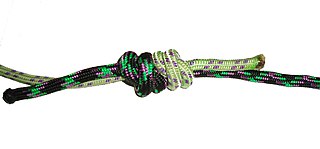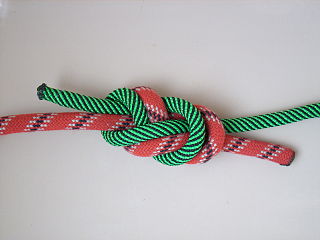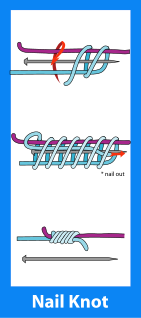 W
WThe adjustable bend is a bend knot that is easy to lengthen or shorten.
 W
WThe Albright special or Albright knot is a bend used in angling. It is a strong knot used to tie two different diameters of line together, for instance to tie monofilament to braid. The Albright is relatively smooth and passes through guides when required. Some anglers coat the knot with a rubber based cement to make it even smoother and more secure.
 W
WAshley's bend is a knot used to securely join the ends of two ropes together. It is similar to several related bend knots which consist of two interlocking overhand knots, and in particular the alpine butterfly bend. These related bends differ by the way the two constituent overhand knots are interlocked.
 W
WThe basket weave knots are a family of bend and lanyard knots with a regular pattern of over–one, under–one. All of these knots are rectangular and lie in a plane. They are named after plait-woven baskets, which have a similar appearance.
 W
WA beer knot is a bend used to join tubular webbing. Its most common application is in constructing slings used in rock climbing. Compared with the water knot, it has the advantages of a higher strength, smaller profile, and a cleaner appearance due to the lack of free-hanging tails. However, the beer knot can be more difficult to tie than the water knot, and one of the tails is hidden from view, making safety checks for adequate tail length more difficult.
 W
WA blood knot is a bend knot most usefully employed for joining sections of monofilament nylon line while maintaining a high portion of the line's inherent strength. Other knots used for this purpose can cause a substantial loss of strength. In fly fishing, this serves to build a leader of gradually decreasing diameter with the castable fly line attached at the large diameter end and the fly or hook at the small diameter end. The principal drawback to the blood knot is the dexterity required to tie it. It is also likely to jam, which is not a concern in fishing line, which is no great loss to cut, but may be a concern in normal rope. "Blood knot" may refer to "a double overhand knot tied in a cat-o'-nine-tails."The barrel knot, called blood knot by Keith Rollo, is the best bend there is for small, stiff or slippery line. The ends may be trimmed short and the knot offers the least resistance possible when drawn through water.
 W
WThe butterfly bend is a knot used to join the ends of two ropes together. It is the analogous bend form of the butterfly loop, in that it is the butterfly loop with the loop cut. The observation that the butterfly loop is secure enough to isolate a worn or damaged section of rope within the loop indicated that the bend form of the knot would be similarly secure.
 W
WThe Carrick bend, also known as the Sailor's breastplate, is a knot used for joining two lines. It is particularly appropriate for very heavy rope or cable that is too large and stiff to be easily formed into other common bends. It will not jam even after carrying a significant load or being soaked with water.
 W
WThe double fisherman's knot or grapevine knot is a bend. This knot and the triple fisherman's knot are the variations used most often in climbing, arboriculture, and search and rescue. The knot is formed by tying a double overhand knot, in its strangle knot form, with each end around the opposite line's standing part.
 W
WThe fisherman's knot is a bend with a symmetrical structure consisting of two overhand knots, each tied around the standing part of the other. Other names for the fisherman's knot include: angler's knot, English knot, halibut knot, waterman's knot.
 W
WThe Flemish bend, also known as a figure eight bend, a rewoven figure eight is a knot for joining two ropes of roughly similar size.
 W
WA grief knot is a knot which combines the features of a granny knot and a thief knot, producing a result which is not generally useful for working purposes. The word grief does not carry its usual meaning but is a portmanteau of granny and thief.
 W
WHalyard bend is a way to attach the end of a rope at right angle to a cylindrical object such as a beam.
 W
WThe harness knot is a general purpose bend knot used to join two ropes together. The knot can be tied under tension and will not capsize.
 W
WThe heaving line bend is a knot for securely joining two ropes of different diameter or rigidity. It is often used to affix playing strings to the thick silk eyes of an anchorage knot in some stringed instruments. In nautical use, the heaving line bend is used to connect a lighter messenger line to a hawser when mooring ships. It is knot number 1463 in The Ashley Book of Knots, and appeared in the 1916 Swedish knot manual Om Knutar.
 W
WHunter's bend is a knot used to join two lines. It consists of interlocking overhand knots, and can jam under moderate strain. It is topologically similar to the Zeppelin bend.
 W
WThe nail knot, also known as the tube knot or gryp knot, is mostly used in carp and fly-fishing. The nail knot was named because a nail was inserted as a guide when threading the line. Today, it is easier to use a small straw. The nail knot is an important fishing knot used to join two lines of different diameters and allows for line diameters to diminish down to the fly. I.E., it is useful for attaching your backing to the fly line, and your fly line to the leader, or tippet. The knot can be tied in multiple ways and is uniform.
 W
WThe offset overhand bend is a knot used to join two ropes together. The offset overhand bend is formed by holding two rope ends next to each other and tying an overhand knot in them as if they were a single line. Due to its common use in several fields, this bend has become known by many names, such as thumb knot, openhand knot, one-sided overhand knot or flat overhand bend (FOB), though the terms "one-sided" and "flat" are considered incorrect.
 W
WThe racking bend is a knot for joining two ropes of different diameter. "Racking" refers to the figure eight weaving that binds the bight of the larger rope together.
 W
WThe Reever Knot is a secure bend for joining two ropes. An important attribute of the knot is that each line going in and out of the knot is clamped at two points within the knot. For this reason it is considered secure and resistant to being shaken loose when subject to intermittent loads.
 W
WThe sheet bend is a bend. It is practical for joining lines of different diameter or rigidity.
 W
WThe shroud knot is a multi-strand bend knot used to join two ends of laid rope together. Shroud knots, in general, are a class of knots in which the individual strands of laid rope are knotted, but not woven, to the individual strands of another laid rope. This makes them more secure than a simple bend but less secure than a full splice.
 W
WThe simple Simon under bend is a knot belonging to the category bend. It was invented by Harry Asher. It is more secure than the similar simple Simon over. The difference is just which of the green ends in the image below is the standing end.
 W
WThe name single carrick bend has been used and even recommended by many different people to refer to different knots with a similar general form to the carrick bend. All of these knots are weaker and less secure for the purpose of a bend which is the connection of two rope ends. Several have other properties which make them desirable for specific uses.
 W
WThe surgeon's knot is a surgical knot and is a simple modification to the reef knot. It adds an extra twist when tying the first throw, forming a double overhand knot. The additional turn provides more friction and can reduce loosening while the second half of the knot is tied. This knot is commonly used by surgeons in situations where it is important to maintain tension on a suture, giving it its name.
 W
WThe Surgeon's loop is tied the same way as the surgeon's knot but with a double strand. Therefore, this knot does use more line than most. It is a bit bulky but is great for making quick, strong loops at the end of lines and leaders for connecting to other loops.
 W
WThe triple fisherman's knot is a bend knot, used to join two ends of rope together. It is an extension of the double fisherman's knot and is recommended for tying slippery, stiff ultra-high-molecular-weight polyethylene (UHMWPE) and aramid cored ropes.
 W
WThe term true lover's knot, also called true love knot is used for many distinct knots. The association of knots with the symbolism of love, friendship and affection dates back to antiquity. Because of this, no single knot can be determined to be the true "true love knot".
 W
WThe uni knot is a multi purpose fishing knot that can be used for attaching the fishing line to the arbor of a reel, for joining lines, and for attaching lures, snaps, and swivels.
 W
WThe water knot is a knot frequently used in climbing for joining two ends of webbing together, for instance when making a sling.
 W
WA Zeppelin bend is an end-to-end joining knot formed by two symmetrically interlinked overhand knots. It is stable, secure, and highly resistant to jamming. It is also resistant to the effects of slack shaking and cyclic loading.
 W
WA zeppelin eye knot, is a secure, jam resistant fixed size loop knot based on the zeppelin bend. It is one of the few eye knots suitable for bungee. It is also special in its ease of untying.
 W
W